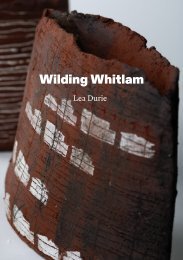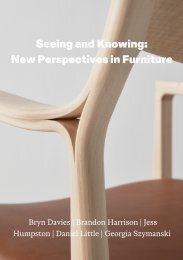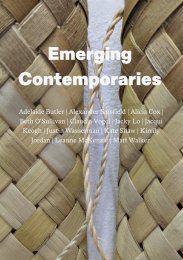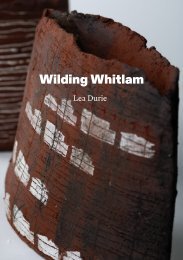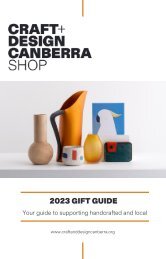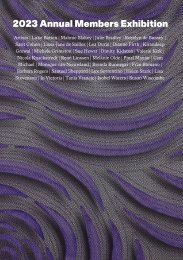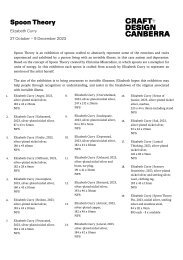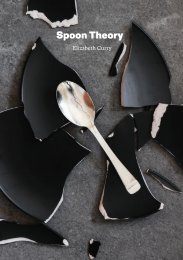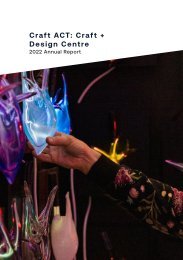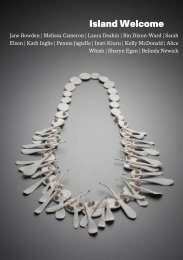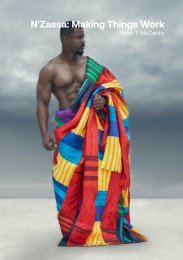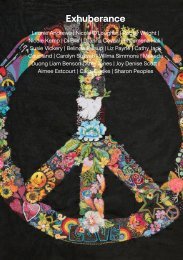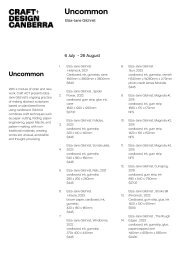'After Landscape' (2010) Exhibition Catalogue
In 2009, THE TREE MUSEUM AND CRAFT ACT: Craft and Design Centre developed an international exchange project. The artists included in this project were Bev Hogg and Trish Roan (Australia), and Penelope Stewart and Jeannie Thib (Canada).
In 2009, THE TREE MUSEUM AND CRAFT ACT: Craft and Design Centre developed an international exchange project. The artists included in this project were Bev Hogg and Trish Roan (Australia), and Penelope Stewart and Jeannie Thib (Canada).
You also want an ePaper? Increase the reach of your titles
YUMPU automatically turns print PDFs into web optimized ePapers that Google loves.
<strong>2010</strong>
I<br />
I
<strong>2010</strong><br />
AFTER LANDSCAPE<br />
September 5 to October 28, <strong>2010</strong><br />
Site-specific installations by<br />
BEV HOGG and TRISH ROAN (Australia)<br />
PENELOPE STEWART and JEANNIE THIB (Canada)<br />
Curated by E.J. LIGHTMAN and ANNE O'CALLAGHAN<br />
<strong>Exhibition</strong> essays:<br />
A Choreography of Movement (Landscape and Orientation)<br />
MARALYNN CHERRY<br />
Under Glass, On The Wall, in the Wind<br />
EARL MILLER<br />
THE TREE MUSEUM<br />
DOE LAKE ROAD · MUSKOKA
2<br />
• CONTENTS<br />
7-'<br />
Introduction 3<br />
E J LIGHT MAN<br />
A Choreography of Movement (Landscape<br />
and Orientation) 9<br />
MARALYNN CHERRY<br />
::.<br />
Under Glass, On The Wall, in the Wind 11<br />
EARL MILLER<br />
Biographical Notes 21<br />
Acknowledgements 24<br />
TRISH ROAN MF/I/DIAN (WORKING PllOCESS) · PHOTO BY ARTIST
INTRODUCTION<br />
3<br />
--i<br />
:c<br />
IN 2009, THE TREE MUSEUM AND CRAFT ACT: Craft and Design Centre in Australia (Canberra) developed an<br />
international exchange project. Anne O'Callaghan, Penelope Stewart, Jeannie Thib and E.J. Lightman, all Canadian<br />
artists, travelled to Australia to engage in artist residencies with Canberra Glassworks, Megalo Print Studio, and the<br />
Australian National University School of Art. We also spent some time in Namadgi Park exploring the nature trails<br />
and breathing in the distinct and unusual landscape that was home to hundreds of kangaroos, and many ocher wild<br />
inhabitants.<br />
In August <strong>2010</strong>, Australian artists Bev Hogg and Trish Roan and Toronto artists Penelope Stewart and Jeannie<br />
Thib crafted individual site specific works ac the Tree Museum, in Gravenhurst, Canada.<br />
The artworks share a reference to the natural light that animated all of these "sculptured spaces." Bev Hogg<br />
framed the light in her mossy, soft area with a camera-like lens, constructed from twigs. Trish Roan directs the light<br />
into pieces of a cut mirror so that the refraction creates the illusion of a hole in a nearby rock formation. A glass jar<br />
captures and illuminates the reflections of the natural surroundings in Penelope Stewart's installation. The sky and the<br />
moon are both the subject and the created objects in Jeannie Thib's expressive piece. These artists experiment with the<br />
idea of the complex, physical nature of light by trying to make the ephemeral realm into something experiential.<br />
The Tree Museum would like to acknowledge all of the inspirational artists and writers who contributed their<br />
endeavors to this extraordinary undertaking. This project would not be possible without your valued contributions.<br />
"'<br />
0<br />
0<br />
E.J. LIGHTMAN
5<br />
A CHOREOGRAPHY OF MOVEMENT (LANDSCAPE AND ORIENTATION)<br />
I AM WALKING TO SITES CAREFULLY CHOSEN. Bev Hogg and Trish Roan recreate a sense of their discoveries, after<br />
many days of being here. Subtle layers of transference are conveyed. They share the task of turning the wonder of a<br />
totally different geographical experience into a shared vision. Notions of <strong>'After</strong> <strong>Landscape'</strong> transform into visceral<br />
experiences of orientation, of getting one's bearings. I think of an internal compass marking one's way in order to<br />
leave from and return to the same site. Trees, rocks, ponds and natural detritus become raw materials utilized as each<br />
artist sets about choreographing entries to experiential focal points. Vision and the body's shifting position become<br />
the magnetic needle, in a sense what Emily Dickinson calls the 'pyramidal nerve'. Lingering reveals a meditative process<br />
as one surrenders to each artist's territorial experience. There is a loosening from the act of reading the landscape in<br />
a historical sense. Each site gathers as raw material what is present in a hidden state. Viewing becomes the point of<br />
discovering and understanding habitat; ecologies and natural rhythms reveal themselves.<br />
Hogg mentions how the earth here is soft beneath our feet and gives way because of the<br />
presence of so much water. The journey to her two sites is a soft walk and her experience of the<br />
dry cracking earth of Australia allows for a sensitive reminder of water's hidden force. She sets up<br />
a meditation median where flat outcroppings of moss/lichen-covered rock beds incline towards<br />
both viewing points. To my left we edge our way towards 'View Finder - Breath' (moss site with<br />
beaver chews). Hogg has gathered delicate sticks and beaver chewed twigs constructing a 'viewing<br />
frame', marking the place where I will stand. My body senses how my view is choreographed<br />
as I look through a framed invisible lens. Perceptions and vision orientate my body. I find myself<br />
standing in front of a rich green field of moss, almost circular, surrounded by trees. In the looking,<br />
my gaze is actively engaged as the eye moves from a tree limb to the imaginary association<br />
of aJapanese miniature garden. The place of viewing marks an invisible line where the body does<br />
not pass. This is a protected place, carefully pictured. Sensations are gathered through sight<br />
rather than touch or physical penetration. A plane surface, en-framed, is perhaps reminiscent of<br />
the canvas, the photographic plate or the phenomenal experience of the panoramic view.<br />
-i<br />
:r<br />
-i<br />
;,:,<br />
,.,,<br />
,.,,<br />
V,<br />
"'<br />
C<br />
3:<br />
....,<br />
0<br />
0<br />
BEV HOGG VIEW FINDER<br />
BREATH (LEFT) · ABOVE DETAIL OF MOSS · PHOTOS BY ARTIST
6<br />
-;<br />
::i:<br />
-;<br />
;,:,<br />
m<br />
,...,<br />
<br />
C<br />
V,<br />
l'T'I<br />
C<br />
<br />
"'<br />
0<br />
0<br />
BEV HOGG VIEW FINDER - GATEWAY· ABOVE PHOTO BY ARTIST • RIGHT PHOTO BY ROGER HENRIQUES
7<br />
"Our reading of this framed miniature world parallels a gallery experience of a similar landscape painting, albeit this one is a living,<br />
breathing image that pulsates shades of green with the changing season, regenerating us with enchantment and repose."<br />
Before we move to a second site, I ask Hogg about her experience as a ceramic artist and her allegorical use of<br />
animals in many of her installations. I wonder if there are associations in the soft pliability of this green moss and<br />
her sensory experience with the plasticity of clay. As we approach a nearby pond, a beaver habitat enters the story of<br />
place. Hogg tells me how beaver feces, in the water, acts as a natural fertilizer generating a re-growth of this 'beaver<br />
field', an environment that feeds a future generation of beavers at the same pond.<br />
The threshold to 'View Finder - Gateway' is marked by a large circle of woven twigs hanging from a rectangular<br />
space. This circular doorway is attached to a straight limb bound between two evergreen trees. I am conscious of<br />
Da Vinci's drawing of the body inside the circle and square, or the oriental symbols of square and circle representing<br />
heaven and earth. Here, Hogg wants us to walk through the circle and enter the site of the beaver pond. There is a hidden<br />
sense of animal architecture; the beaver lodge is somewhere nearby. Our sightings involve a<br />
kind of displacement, a moving through a hole in space to find and to attend what is here. She<br />
mentions her experience as a ceramic artist shaping clay pots, creating a kind of containment.<br />
But here at this site, containment loosens, becoming an expansive opening out and into the<br />
space of the beaver pond. In a sense, we are breathing with the beaver as the still waters of the<br />
pond reflect and mediate an endless array of views.<br />
-;<br />
I<br />
-;<br />
;,:,<br />
/'Tl<br />
/'Tl<br />
<br />
C<br />
V,<br />
/'Tl<br />
"'<br />
0<br />
0<br />
"Gateway brings us to a gathering point both physically and mentally. At this transitional point our gaze is<br />
simultaneously drawn forward to the framed waterscape before us and to our mediated future of interdependence<br />
with nature."<br />
Before visiting Trish Roan's site' Meridian', I watch her engineering, the moving back panels<br />
that will hold and manipulate a series of small mirrors. These are squares of wood, each holding<br />
two short pieces of wooden dowling, one vertical and the other horizontal. The dowling is held
8<br />
;;::;<br />
V'"<br />
..,.,<br />
...,<br />
0<br />
TRISH ROAN MERIDIAN (<strong>2010</strong>) • RIGHT DETAIL OF MIRRORS • PHOTOS BY ARTIST
9<br />
in place by half circle copper joiners that allow for plane motion to be guided along an up/down or sideways axis.<br />
Such a witty handed sense of engineering captivates me immediately. As a glass artist, Roan keenly aligns her poetic<br />
wonder with a love for empirical knowledge gathered from experience. My pathway to her location is guided by tied<br />
pieces of coloured trail ribbon and hearing her voice from a point in the distance. I climb down into a cavern of trees<br />
beside a dynamic rock cliff. There is a keen sense of re-orientation as one's movements glean the forces of light, time of<br />
day and the slow meditative process of remembering how to find one's way. Roan is perched above me on a section<br />
of rock. She is twine-binding one of her mirrors to a branch. This artist has carefully surveyed, levelled and placed a<br />
series of mirrors in this grove of trees. Seeing what is here has been, for Roan, a choreography of measure. The still<br />
point of reference is the sun, moving through the site. An elliptic source of light, if observed, gleans time passing.<br />
Techniques of location and their simple tools of design have been in play for Roan since finding this place. Start with<br />
a primitive gnomon, a stick, some blue chalk and draw out the shadow lengths as the sun passes over the top of the<br />
rock plateau. 'Finding noon' spells a magic and a remembering of early wayfarers. Intuition aligns with inherent laws<br />
of measurement.<br />
Roan mentions, "something called a 'noon-mark' - a simple timekeeper that, rather than telling the hours of the day like most<br />
sundials, notes only the moment of noon .... they were used by people to correct their mechanical clocks. They were in the form of a lens<br />
set above a carved line that lay on the meridian line (North-South)."<br />
Coming here at a specified time, each day, reveals cyclic rhythms. I am meant to arrive between noon and 1 :30 pm.<br />
There is a depth-of-field and meaning to the placement of each circular-cut mirror. Roan draws my attention to a jutting<br />
triangular rock formation that sculpts a sheltered focal point, evenly positioned, between two straight tree limbs.<br />
Standing in front of this spot, looking back towards the mirrors, I see cut out reflections of trees, leaves, blue sky and<br />
clouds. Roan directs me co find a space behind, and somewhat level with, the mirrors. (She stands on a chair, or climbs<br />
on rocks, to subtly align each mirror.) Initially, all is in Aux as light patterns and shadows are reflected above and co<br />
che side of che triangular rock face. 'The mirrors are fragments of the circle and the light reflections while separated move through<br />
the day to intersect at 'that one moment' before breaking up again." Roan is gathering the sun's rays, creating an illuminated<br />
circle that appears for a fleeting moment at a singular focal point, a meridian. A solar orb of light reflects an astronomical<br />
shift of time as the rotation of the earth's axis reveals itself in relation to the sun's motion.<br />
-I<br />
:r<br />
m<br />
-I<br />
:;o<br />
m<br />
m<br />
<br />
C<br />
V,<br />
m<br />
C<br />
<br />
Iv<br />
0<br />
0
10<br />
-I<br />
-I<br />
;,:,<br />
...,<br />
m<br />
<br />
C<br />
V,<br />
...,<br />
C<br />
:::<br />
"'<br />
0<br />
o<br />
'This moment (this image) is not terribly different from every other moment. The only thing is that it is made visible, through<br />
being defined by a form that we can recognize ... How do you define that moment? You know that it has to exist in order for one<br />
direction (before) to change into the other (after), and it is created in crossing over."<br />
The works of Bev Hogg and Trish Roan invite us to re-kindle our inherent tools of perception. For it is from this<br />
primary source that the subtle layers of orientation begin the history of'being in' and 'reading' the landscape. There is<br />
a phenomenological sensitivity to these works; my body engages in acts of perception that enliven its presence within<br />
nature itself. Each artist creates a liminal threshold to experience what was always there. The body itself enters into<br />
dialogue: "... the boundaries of a living body are open and indeterminate; more like membranes than barriers, they define a surface<br />
of metamorphosis and exchange. "<br />
MARALYNN CHERRY<br />
TRISH ROAN MERIDIAN (WORKING PROCESS) • PHOTO BY ARTIST
11<br />
UNDER GLASS, ON THE WALL, IN THE WILD<br />
REPRESENTING NATURE THROUGH ART has become increasingly complex as humanity becomes increasingly distant<br />
from nature. The simple divide between culture and nature - Kant's legacy of art imitating nature yet never becoming<br />
part of it - has become clouded, for one thing by culture's omnipresent environmental imprint. Undeniably, the division<br />
is no longer clear, but we are not so alienated from the landscape that nature is equatable to culture. Accordingly,<br />
Jeannie Thib and Penelope Stewart explore the murky middle ground between culture and nature with acculturalized<br />
representations of nature in their installations at the Tree Museum.<br />
Walking along the unpaved road winding through the Tree Museum, passing by a line of permanent roadside<br />
installations, one will encounter two new site-specific pieces by Jeannie Thib and Penelope Stewart. Thib's installation,<br />
Equivalents (Tree Museum) after Muniz, after Stieglitz ( <strong>2010</strong>), the first of the two, comprises a painting of clouds ( 6 x 6 feet)<br />
mounted on a large erratic boulder looming behind a small marble disk (18 x18 inches) on the ground. For Cloche<br />
(<strong>2010</strong>), Stewart has installed a colour photograph, printed on a 12 x 9 feet vinyl sheet, depicting a garden viewed<br />
through a trans-parent cloche or bell jar - a solid glass dome used to protect garden plants from cold and frost. The<br />
clouds and the cloche's landscape view are both representations of nature, and so they belong on site. Yet as twodimensional<br />
works, they seem, paradoxically, more comfortable in a conventional museum or gallery.<br />
Thib's marble disk lies fittingly on the forest ground even though it represents the moon. Thib clarifies that "the<br />
patterning on this lichen-covered, curving granite slope suggested a celestial sky and hence a suitable place for the<br />
moon." 1 This poetic installation is spare enough to depend on natural surroundings to complete it. The painting of<br />
clouds behind the disk is rendered in black exterior house paint on birch bark in sharp linear brushstrokes that resemble<br />
the inky lines resulting from gouge marks on a woodblock. Sourcing from 19th and early 20th century Australian<br />
and North American wood engravings, Thib's finished painting is a conglomerate of cloud imagery.<br />
Thib's installation may at first read as anomalous from her previous work. Marnie Fleming notes that Thib was<br />
exploring the human body "as artifact or archive." 2 Still though, Thib engaged in an approach that was "anchored in<br />
the museum's ordering and classifying structures.'' 3 Returning to this approach for her Tree Museum installation, she<br />
--i<br />
I<br />
--i<br />
;,::,<br />
m<br />
m<br />
V,<br />
m<br />
C<br />
3:<br />
...,<br />
0<br />
0<br />
references a photographic series by Vik Muniz, Equivalents (Museum of Modern Art) (1995), which responds to the museum
12<br />
I<br />
-,<br />
;;e<br />
,...,<br />
0<br />
0<br />
JEANNIE THIB EQUIVALENTS (TREE MUSEUM) AFTER MUNIZ, AFTER STIEGLITZ (<strong>2010</strong>)<br />
SITE WORK IN TWO PARTS· WOOD PANEL, BIRCH BARK, ACRYLIC PAINT (6 X 6 FEET) MOUNTED ON A LARGE ERRATIC<br />
BOULDER, AND CARRARA MARBLE DISC ( 18 X 18 X 3/4 INCHES) ON THE GROUND NEARBY • PHOTOS BY ARTIST
13<br />
through his remaking of Alfred Stieglitz's Equivalents series, about 220 photographs of clouds taken between 1925 and<br />
1934. They were canonical in the overlapping histories of Modernism and photography, as they are generally considered<br />
the first intentionally abstract photographs. Stieglitz states that in this series, "True meaning ... comes through directly,<br />
without any extraneous or distracting pictorial or representation factors coming between the person and the picture." 4<br />
Over half a century later, Muniz, when viewing Stieglitz's photographs at the Museum of Modern Art, realized that<br />
patterns on the museum's marble floor coincidentally resembled Stieglitz's abstracted clouds. Deciding to photograph<br />
the floor to reconstruct Stieglitz's photographs, he then completed his simulation by cutting black paper silhouettes to<br />
represent landscape and placing a dime above the silhouettes as a stand-in for the moon. By connecting the museum's<br />
architectural features to the original Equivalents, Muniz satirically highlights how museum context affects viewing art<br />
- an ironical premise since Stieglitz intended to eliminate distraction between viewer and image. Conversely, Muniz<br />
illustrates how high Modernism depends upon the museum, with its attendant elitism and traditionalism, for exhibition<br />
- despite the museum's contradictory disruption of the intended private, if not hermetic, relationship between<br />
viewer and abstract object.<br />
Thib recalls that the Tree Museum site "seemed particularly interesting within the context of an outdoor museum<br />
and suggested the possibility of incorporating reference to the collections and practices of more traditional museums. " 5<br />
Indeed, Thib's piece is a chain of references, beginning with her representation ofMuniz's Equivalents, which is, in turn,<br />
a representation of photographic representations of nature (Stieglitz's Equivalents). The culmination of this appropriation<br />
of the appropriated is considerable visual difference between Stieglitz's and Thib's work. Certainly, one would<br />
have to either note the piece's title or read Thib's artist's statement to know the Equivalents series<br />
is being alluded to. Moreover, Thib's installation includes none of Muniz's humble everyday<br />
material - coins or paper - but her marble disc does reference Muniz's photographing of the<br />
museum floor and harkens classical sculpture.<br />
Further referencing the museum is Thib's two-dimensional, wall-intended painting as well<br />
as the boulder, which despite its glacial origins, serves as a plinth - albeit a crude, oversized one.<br />
Alluding to a museum by using a natural site as a readymade, Thib's installation is as absurdly<br />
displaced as it is appropriately site-specific.<br />
,...,<br />
--i<br />
;,::,<br />
,...,<br />
,...,<br />
<br />
C<br />
V><br />
,...,<br />
C<br />
<br />
"-'<br />
0<br />
0
14<br />
IV<br />
0<br />
0<br />
I<br />
{<br />
l<br />
i<br />
l<br />
JEANNIE THIB NAMADGI 2 (2009) SCREENPRINT ON KOZO PAPER, EDITION 4 , 23 1/ 2 X 35 1/ 2 INCHES • PHOTO BY TORONTO IMAGE WORKS
15<br />
Thib's placement of her work outside in an alternative museum distances it fro m a conventional museum, but at<br />
the same time, keeps it within a museum paradigm. Distancing, but from the inside, is ideal for reflexive institutional<br />
critique. Thib, first of all, critiques the museum simply by allegorizing Muniz's work; after all, Muniz performed what<br />
could be termed a nee-institutional critique ("neo" because it post-dates the work of Micheal Asher, Hans Haacke,<br />
Daniel Buren et al by about four decades) of the museum's defeat of Modernist ideals. Thib amplifies Muniz's critique<br />
by only loosely referencing Stieglitz's imagery because its dissipation outside of the museum implies his work cannot<br />
function at all when free of marble and columns.<br />
In addition to highlighting Muniz's critique, Thib points out how far-reaching the influence of the museum is for<br />
:s::<br />
C<br />
V,<br />
rn<br />
C<br />
:s::<br />
IV<br />
0<br />
0<br />
it co pervade in such a remote location. Siting her installations in a forest but not escaping the spectral appearance of<br />
the museum illustrates just how far culture has permeated nature.<br />
Penelope Stewart, likewise, provides a culturally infused representation of nature amidst what is actually natural.<br />
Set slightly in from the road at the far end of a clearing, trees looming behind it, Stewart's Cloche depicts the powerful<br />
sculptural form of an oversized bell jar. The cloche appears to be filled with greenery, but what one initially mistakes<br />
for its contents is a view of Kiwi Gardens in Perth, Ontario, which has been photographed through the glass bell jar.<br />
Stewart's cloche encloses empty space while nature surrounds it - the ironical opposite of a cloche's typical use. Additionally,<br />
creating a fractured image of nature, the glass knob topping the cloche acts as a camera obscura, causing the<br />
image reflected in the knob to appear upside down because of its curvature. Finally, Stewart pri nted photogra phs on<br />
either side of the vinyl and reversed them to create the illusion one is looking through the cloche. While thereby simulating<br />
a true image, Stewart clarifies that the work is allusional: "The scale of the photographs and the transparency<br />
of the glass immediately conjure up the Victorian glass greenhouse whose function it was to create, collect, and make<br />
spectacle of the magic of the natural and the exotic while in an environment of control and containment." Accordingly,<br />
Cloche recalls Stewart's earlier work, Genius Loci, which drew conceptually and sometimes imagistically from<br />
the many conservatories built across North America and Europe in the 19th and 20th centuries. Not only referencing<br />
a conservatory because of its large scale, Stewart's cloche also relates to a conservatory for its enclosure and control<br />
of nature.
17<br />
Stewart's representation of culturally constructed nature is what could be deemed a heterotopia, Michel Foucault's<br />
term that refers to "real places - places that do exist and that are formed in the very founding of society- which<br />
are something like counter-sites, a kind of effectively enacted utopia in which the real sites, all the other real sites that<br />
can be found within the culture, are simultaneously represented, contested, and inverted. " 7 A garden definitively is certainly<br />
this paradoxical "enacted utopia," a place of escape that is separate from overall public space - the "real sites"<br />
surrounding it. Still, it relieves the stress of real space, and is hence an inversion of it - an idealized foil. Appropriately,<br />
Foucault uses a garden as an example of a heterotopia. 8<br />
The garden, like all heterotopias, is a socially engaged construction. It is a manufactured paradise, which Robert<br />
Smithson was notably critical of, viewing it as a common but sadly artificial site for public sculpture. Smithson argues<br />
-t<br />
I<br />
,.,.,<br />
-t<br />
;c<br />
,.,.,<br />
,.,.,<br />
:s:<br />
C<br />
V><br />
,.,.,<br />
C<br />
?:<br />
0<br />
that "parks are idealizations of nature, but nature in fact is not a condition of the ideal. Nature does not proceed in<br />
a straight line; it is, rather, a sprawling development. Nature is never finished." 9<br />
Smithson bluntly asks, "Could one say that art degenerates as it approaches gardening?" 10 Smithson was interested<br />
in the reality of natural spaces, which he called "non-sites," as places for art to attune to or blend in with nature.<br />
As Sue Malvern and Eckart Marchand put it, "Smithson saw his non-sites as a deliberate strategy to replace the manmade<br />
work of art in the picturesque landscape setting ...'' 11 Smithson's intent was that his work form a dialectical<br />
relationship between his work and nature, therefore reaching a resolution with nature despite initial differences.<br />
The natural, or nearly natural, forest Stewart and Thib have installed in is comparable to a "non-site." However,<br />
their placement of acculturalized natural images in the forest - the museological moon and clouds or the cloche's<br />
reflection of gardens - illustrates that Smithson's attempt to bridge the culture/nature dichotomy dialectically is<br />
problematic because culture's reach is too far. That Smithson's earth works are now most often seen in a museum<br />
as documentation testifies to the fading idealism they once embodied. In fact, Craig Owens, in the second part of<br />
his seminal essay, "The Allegorical Impulse: Toward a Theory of Postmodern ism" observed how a generation of postmodern<br />
artists in the late seventies had already conceded that nature was blending into culture: "The nature/culture<br />
opposition [ is J a presupposition that postmodern artists - not to mention their post-structuralist counterparts - are<br />
determined to subvert. In postmodernist art, nature is treated as wholly domesticated by culture; the "natural" can be<br />
approached only through its cultural representation." 12 There is no dichotomy awaiting resolution.<br />
PENELOPE STEWART CLOCHE 12 X 9 FEET, COLOUR PHOTOGRAPH MOUNTED ON PANEL ' PHOTO BY ARTIST
18<br />
-i<br />
I<br />
-,<br />
;a<br />
m<br />
,...,<br />
V><br />
,...<br />
C<br />
r<br />
0<br />
· b · chat subverting che culture/ nature d ivid e "demonscraces ... the impossibility of<br />
wens connn ues y arguing<br />
· h ·<br />
accepting c e1r oppos1c1on ...<br />
· ·<br />
11 n A lthough chis opposition is certainly becoming less pronounced , it is d isi ngenuous co<br />
claim that n o difference exists between culture and nature. Jacques Derrida, for chis reason, believes that d e construction<br />
is the best way to approach this opposition : "Despite all its rej uvenations and d isguises, this opposition [ between<br />
nature and culture J is congenital co philosophy. le is even older than Plato. le is at least as old as the Sophists ...<br />
Levi-Strauss simultaneously has experienced the necessity of utilizing chis opposition and the impossibility of accepting<br />
ic." 1 • Thib and Stewart similarly enact a nature/culture split - either the museum or the greenhouse versus the<br />
"'0<br />
0<br />
forest - but refuse co accept it , as they blur the bou ndaries between culture and nature by opening up the architecture<br />
of museums and conservator i<br />
es, by emptying their contents - modern arc and monito red gardens - into a natural<br />
space . Their wo rk, co nsequent l<br />
y<br />
,<br />
meets De r ida's defin ition of deconstruction - a critiq ue of aspects of a system clear l<br />
y<br />
troubled but u nchangeable . While such a crit i<br />
que may r i<br />
ng pessimistically, Derrida cont i<br />
n ues that the culture/nature<br />
polarization sho u ld be addressed with a "readi ness co abandon [it], if necessary, should oche r instruments appear<br />
more useful." 15 Thib and Stewa r t stress chat it is currently impossib l<br />
e co see nature and culture as enti<br />
r ely merged<br />
entities, meaning they are closer co Derrida than Owens in ma intaining but question i<br />
ng the somewhat conc r adiccious<br />
polarization of culture and nature. As The Tree Museum itself already intr i<br />
nsica lly questions such cont r ad ictions '<br />
ask i<br />
ng, for instance ,<br />
how natural can nature be when it becomes a museum, it is an ideal site fo r Jeannie Thib and<br />
Penelope Stewart co furthe r such conversations.<br />
EARL MILLER
19<br />
NOTES<br />
1 Jeannie Th,b, Artist's Statement <strong>2010</strong> 18 Oct <strong>2010</strong><br />
<br />
2 Marnie Flem,ng,Jeannie Thib: Model/Mimic (Oakv,lle· Oakville<br />
Galleries, 1997) 7.<br />
-I<br />
-I<br />
;,:,<br />
m<br />
m<br />
3 Fleming, 3<br />
4 Alfred St,egl,tz, S11egl1tz on Photography: His Seleaed Essays and Notes, ed<br />
Richard Whelan (New York: Aperture, 2000) 238.<br />
5 Jeannie Thib, Artist's Statement. <strong>2010</strong>. 18 Oct museum.ca/<br />
treemuseum/index.html><br />
6 Penelope Stewart, Artist's Statement. 2008. 18 Oct. <strong>2010</strong><br />
<br />
C<br />
"'<br />
0<br />
0<br />
7 Michel Foucault, "Of Other Spaces," Architecture, Mouvement,<br />
Continuitt S (1984). 20 Oct. <strong>2010</strong>. <br />
8 Mochel Foucault, "Of Other Spaces."<br />
9 Robert Smithson, Robert Smithson: The Collected Wntmgs, "Cultural<br />
Confinement,• ed. Jack Flam. ( Berkeley and Los Angeles: Un,vers,ty<br />
ofCaliforn,a Press, 1 996) 155.<br />
10 Robert Smithson, "A Sedimentation of the Mond: Earth Proieccs,"<br />
105.<br />
11 Sue Malvern and Eckart Marchand, "Sculpture ,n Arcadia," Studies ,n<br />
the History of Gardens Designed Landscapes 29.1 (2009): 1-12. 18 Oct.<br />
<strong>2010</strong>. http://dx.doi.org/10. 1 080/ 14601170701 806908<br />
12 Craig Owens, "The Allegoncal Impulse: Toward a Theory of Post<br />
modernism Pan: 2," October 13 (Summer, 1980): 58-80.<br />
13 Craig Owens, 58-80<br />
14 Jacques Derrida, "Structure, Sign, and Play," Wrotmg and Difference<br />
(Chicago: The University of Chicago Press, 1978) 282-283<br />
15 Derrida, 284<br />
PENELOPE STEWART<br />
GLOBE<br />
POND FOR DOSSIER (LEFT)<br />
I<br />
GLOBE SKY FOR DOSSIER (TOP)<br />
GLOBE TWIN PINES FOR DOSSIER (ABOVE)<br />
PHOTOS BY ARTST
20<br />
:::<br />
C<br />
V,<br />
m<br />
C<br />
"'<br />
0<br />
0<br />
ART STEINBURG 1947- 2011<br />
I think the smile says it all, open and giving.<br />
An accomplished educator, leader and<br />
humanitaria n, A. rt Steinberg worked tirelessly '·.<br />
on 1n1t1at1ves designed to make our world a 'J.J.·'<br />
berter place. His passion for helping young 1,f.f·<br />
people co achieve their goals was borderless tff{<br />
and l1m1cless. From guiding students at the 1{~ 11 fg<br />
school he helped found, Mentor College in {) ,<br />
1981, to building a school in a small village \ ' ~<br />
in Cambodia, so t hat children in Cambodia 1<br />
would have the same opportunities as children f<br />
in Toronto .<br />
I will remember Art most for the support he<br />
gave to E.J . Lightman, his wife, and myself to<br />
rea lize our dream of an outdoor art site, The<br />
Tree Museum. His financial support ofThe'<br />
Tree Museum was crucial, but it was his tireless<br />
encouragement a nd good humour that I<br />
valued the most. One of my last and fondest<br />
memori es will be Art driving me across Ryde<br />
Lake, a bitterly cold day, so that I could cake a<br />
photograph of Bev Hogg's work in the snow.<br />
I<br />
Art's passion and support for fam ily, friends<br />
and for community will be sorely missed.<br />
ANNE O 'CALL AGHAN, FR IEND<br />
PHOTO BY ANNE O'CALLAGHAN
21<br />
BIOGRAPHICAL NOTES<br />
BEV HOGG: Born in rural West Australia, Bev grew up on a farm<br />
with space to breathe and space for creativity. Since graduating<br />
from Australian National University School of Art in 1989, she<br />
has been working as a visual artist, exhibiting nationally and<br />
internationally. Her multi-faceted practice includes exhibiting<br />
sculptural ceramic incorporating mixed media, public art, workshops<br />
and teaching. Her work has won several major awards<br />
including the Canberra Circle Visual Arts Award twice, The<br />
National Ceramic Award and the Doug Alexander Memorial<br />
Award. Her work is represented in public collections in Australia's<br />
Parliament House, Artbank, Goulburn Regional Gallery<br />
and Canberra Museum and Gallery. In her career to date Bev<br />
acknowledges the support of Arts ACT for the Creative Arts Fellowship<br />
in 2007; The Australia Council for a studio residency in<br />
Barcelona in 1996-97 and again in 2006 when they show-cased<br />
her work at Sculpture Objects and Functional Art in Chicago.<br />
PENELOPE STEWART was born in Montreal, Quebec and has<br />
lived in numerous cites in Canada, Europe and the US. In 2007<br />
she received an MFA from the State University of New York<br />
(SUNY) at Buffalo and in 2009 she was elected to the Royal<br />
Canadian Academy of the Arts (RCA). Her work has been<br />
exhibited in touring solo and group exhibitions nationally and<br />
internationally since 1992 with key exhibitions in Canada,<br />
Australia, France, the Netherlands, Italy, Czech and the United<br />
States. Most recently, her large architectural interventions were<br />
included in the <strong>2010</strong> International Biennale at the Albright Knox<br />
Art Gallery, Buffalo, New York followed by an in situ installation<br />
at Oakville Galleries, Oakville, Ontario.<br />
Stewart has received numerous grants and awards and has been<br />
an artist in residence at Canberra Glassworks, Austra lia (2009);<br />
the International School of Art in Montecastello, Ita ly ( 2009);<br />
Musee Barthete, Boussan, France (2007); Engramme, Quebec<br />
City, QC. (2006); Stichting Kunst & Complex, Rotterdam, NL<br />
(2003 ).<br />
Publication and reviews of Stewart's projects can be read in<br />
books, magazines, newspapers and catalogues: Canadian Architect,<br />
Canadian Art, Globe & Mail, Toronto Star, Le Solie/, Le Devoir,<br />
etc. Her work is held in public, corporate and private collections<br />
including the Department of Foreign Affairs, Cambridge Galleries,<br />
Ontario Securities Commission, lnco, York University, Oxford<br />
Properties and the United Church of Canada.<br />
Penelope Stewart currently lives in Toronto. She is represented<br />
by Edward Day Gallery, Toronto.<br />
www.penelopestewart.ca www.ccca .ca www.eddayga llery.com<br />
TRISH ROAN grew up in Melbourne, Australia, and moved to<br />
Canberra to study glass at the ANU School of Art, finishing with<br />
Honours in 2006. Since then she has been working as a glassblowing<br />
assistant for several artists, as well as working in her<br />
own studio as part of the artist-run facility ANCA (Australian<br />
National Capital Artists). She has exhibited her work in various<br />
locations in Canberra, a s well as further afield in Australia with<br />
the touring group exhibition 'Tour de Force: in case of emergency<br />
break glass', <strong>2010</strong>-11. Trish spent the second halfof <strong>2010</strong> in<br />
Canada, undertaking residencies at the Tree Museum and<br />
Alberta College of Art and Design, and doing volunteer work<br />
while travelling overland from Ontario to British Columbia.<br />
Her world quietly changed forever upon seeing a snowflake for<br />
the first time. Trish's practice lies somewhere in the margins<br />
of crude science and everyday miracles.<br />
N<br />
0<br />
0
22<br />
-f<br />
I<br />
m<br />
;,:,<br />
m<br />
,...,<br />
V,<br />
,.,.,<br />
C<br />
<br />
....<br />
0<br />
0<br />
JEANNIE THIB was born in North Bay, Ontario, Canada and<br />
received a BFA from York University, Toronto. She has been<br />
working as a visual artist since the 1980s, exhibiting nationally<br />
and internationally. Recent exhibitions include Making and<br />
Meaning at Object Gallery, Sydney, Australia, Glifo at Museo<br />
de Arte INBA, Ciudad Juarez, Mexico and Fae-simile at Maison<br />
Pacrimoniale de Barth ere, Boussan, France. Her work is represented<br />
in numerous collections including The National Gallery<br />
of Canada, Musee des Beaux-Aru de Montreal, and The Washington<br />
DC Convention Center, USA. Thib has been commissioned<br />
to create permanent public artworks for the Royal Bank<br />
Centre Dexia, Toronto, the Esplanade Aru and Heritage Centre,<br />
Medicine Hae, Alberta and the City of Toronto's Downsview<br />
Memorial Parkette among others. Her artist residencies include<br />
the Canada Council Paris Studio in France, Stichting Kunst and<br />
Complex in Rotterdam and Megalo Print Studio in Canberra,<br />
Australia. Recent publications include Lure, a bilingual exhibition<br />
catalogue and 'The Map as Art' published by Princeton Architectural<br />
Press and edited by Katherine Harmon. Jeannie Thib is<br />
represented in Copenhagen, Denmark by 8 and K Projects and<br />
in Canada by Leo Kamen Gallery, Toronto and Ferneyhough<br />
Contemporary, North Bay.<br />
EARL MILLER (Edmonton, Alberta). Lives and works in Toronto.<br />
An independent art writer and curator, Miller has published in<br />
Canadian and international art, design and craft magazines<br />
including Art Asia Pacific, Arts Atlantic, Art Papers, Azure, Border<br />
Crossings, C Magazine, Canadian Art, Ceramic Art and Perception,<br />
Fiber Arts, Flash Art, Parachute, Prefix Photo, and Surface Design.<br />
He has written numerous catalogue essays in Canada as well as<br />
in Asia, Europe, and South America. He has curated exhibitions<br />
at Inter Access, Galeria Vermelho (Sao Paulo), York Quay Gallery,<br />
the Art Gallery ofYork University, Red Bull 381 Projects, Doris<br />
McCarthy Art Gallery and the Kenderdine Art Gallery.<br />
MARAL YNN CHERRY is a graduate of the Ontario College of Art.<br />
She is a practicing installation and mixed media artist. Cherry<br />
is an Adjunct Faculty member in Cultural Studies at Trent University<br />
and the Curator at the Visual Arts Centre of Claringt on.<br />
She has been an independent curator and has written numerous<br />
catalogue essays and articles including the curatorial project<br />
Dream Ecolol)'. In 1996 Cherry was part of the Millennium Project<br />
at Cataraqui Creek through Modern Fuel Gallery, creating an<br />
outdoor installation, performance and bookwork titled Ecological<br />
Diaries.<br />
As an artist she has also received Arts in Education Grants ,<br />
project and exhibition grants from the Ontario Arts Council.<br />
Her most recent work includes video, etched stone, raw unspun<br />
wool on plexi, wax on wood and a layered book work with text<br />
that documents her ongoing exploration of rivers.<br />
E.J. LICHTMAN, an artist based in Toronto, is a founding member<br />
ofThe Tree Museum (1997), and co-curator and organizer<br />
of the site-specific outdoor installations at The Tree Museum<br />
Gravenhurst, Ontaro. She has exhibited in Canada, the Unite<br />
States, Europe, Central and South America, and M exico.<br />
Lightman was an active member ofWorkScene Gallery in<br />
Toronto from its inception in 1989, curating several group<br />
shows, including Art & Technology ( 1994 ). She also co-curated<br />
Myths from Cyberspace (1996/97) with Carolyn Bell Farrell at the<br />
Koffler Centre, Toronto. <strong>Exhibition</strong>s include mixed media works<br />
Natural Icons (Tusk Gallery, Toronto, 2001) and The Tree Museum<br />
Collective: An Alternative Site (Visual Arts York Quay Centre,<br />
Harbourfront Centre, Toronto, Ontario, 2002); the Visual Arts<br />
entre in Clarington, Ontario (2008); and site-specific installations<br />
at The Tree Museum (2005 and 2007); and Oeno Gall<br />
. .<br />
in Prince Edward County, Ontario (2007); Haliburton Forest<br />
Reserve, Ontario (2009).<br />
ery
23<br />
ANNE O'CALLAGHAN, work extends from photo-based work<br />
to sire-specific sculpture. Selected site-specific installations<br />
include, The Tree Museum ( 1998-99); The Visual Arcs Centre of<br />
Clarington, Ontario (Public Arc Project 2001-2003 ); An Artist<br />
C,arden, Visual Arcs, York Quay Centre, Harbourfronc Centre,<br />
Toronto, Ontario (2003 co present); Fifchcown. Prince Edward<br />
County, Ontario, and Kiwi Gardens, Perch, Ontario (2008).<br />
Selected exhibitions include: Redhead Gallery, Toronto (2004,<br />
2006); The Visual Arcs Centre of Clarington (2002, 2004, 2007);<br />
Oeno Gallery (2005, 2007); Visual Arcs York Quay Gallery at<br />
Harbourfronc Centre Toronto (2002, 2007). As well as a practicing<br />
artist O'Callaghan has an active curatorial practice. She<br />
is the co-curator and a founding member ofThe Tree Museum,<br />
Gravenhursc, Ontario, and a founding member of "the intersperse<br />
curatorial collective". Born in Ireland, O'Callaghan lives<br />
and works in Toronto, Ontario and is represented by Oeno<br />
Gallery, Prince Edward County, Ontario.<br />
-i<br />
I<br />
-i<br />
;,o<br />
m<br />
m<br />
N<br />
0<br />
0
24<br />
....<br />
I<br />
....<br />
;,,<br />
C<br />
;::<br />
0<br />
ACKNOWLEDGEMENTS<br />
THE TREE MUSEUM acknowledges the financial support of;<br />
E.J. Lightman, Art Steinberg, The Canada Council for the Arts,<br />
The Ontario Arts Council and The Walter and Duncan Gordon<br />
Foundation, for <strong>2010</strong> exhibition and catalogue. We also thank<br />
Roger Henriques of Rhen Communications Group for designing<br />
and maintaining The Tree Museum web site.<br />
PENELOPE STEWART wishes to thank the following for their<br />
support and assistance: Ontario Arts Council, The Canada<br />
Council for the Arts, The Toronto Arts Council, The Walter<br />
Gordon Foundation, Jean-Guy Hache, Pierre Cote, Andrea Cote,<br />
Nathaniel Cote, Orest Tataryn, E.j. Lightman, Art Steinberg<br />
and Anne O'Callaghan.<br />
The Tree Museum<br />
Curator: E.J. Lightman and Anne O'Callaghan<br />
Administrator/co-coordinator: Anne O'Callaghan<br />
<strong>Catalogue</strong> Design: J. Lynn Campbell<br />
<strong>Catalogue</strong> Editor: Anne O'Callaghan<br />
ISBN 978-0-9809879-5-9<br />
A cataloguing record for this publication is available from<br />
Library and Archives Canada.<br />
© The Tree Museum, contributing writers and artists 201 o.<br />
Al I rights reserved.<br />
JEANNIE THIB gratefully acknowledges the support of the<br />
Ontario Arts Council and The Tree Museum in Canada: Megalo<br />
Print Studio, Craft ACT, and the Namadgi National Park Artist<br />
Residency in Australia. Special thanks to Bruce Holland and<br />
Orest Tataryn for fabrication and installation assistance.<br />
The Tree Museum<br />
1634 Doe Lake Road, Muskoka, Ontario<br />
http://www.thetreemuseum.ca<br />
TRISH ROAN thanks the Ian Potter Cultural Trust for their<br />
financial support of emerging Australian artists. She is very<br />
grateful for the generosity of Anne O'Callaghan, E.J. Lightman,<br />
Barb McConchie, Art Steinberg, Maralynn Cherry, John Dickson,<br />
Deeter Hastenreufel, Romy and Sari Lightman and friends,<br />
and each one of the wonderful artists we met in our time at the<br />
Tree Museum. And a special thank you to Bev, Penelope and<br />
Jeannie for their inspiration and friendship.<br />
c.n.doCound<br />
............<br />
ConMldo,M,<br />
du Canada<br />
Y.•ltc, ,I, D11n••n<br />
GOROON FOUNDA.mN<br />
ONTARIO AATS COUNCIL<br />
JW\ CONSEIL DU ARTS DE l'ONTARIO
THE TREE MUSEUM<br />
DOE LAK E ROAD<br />
MUSKOKA




